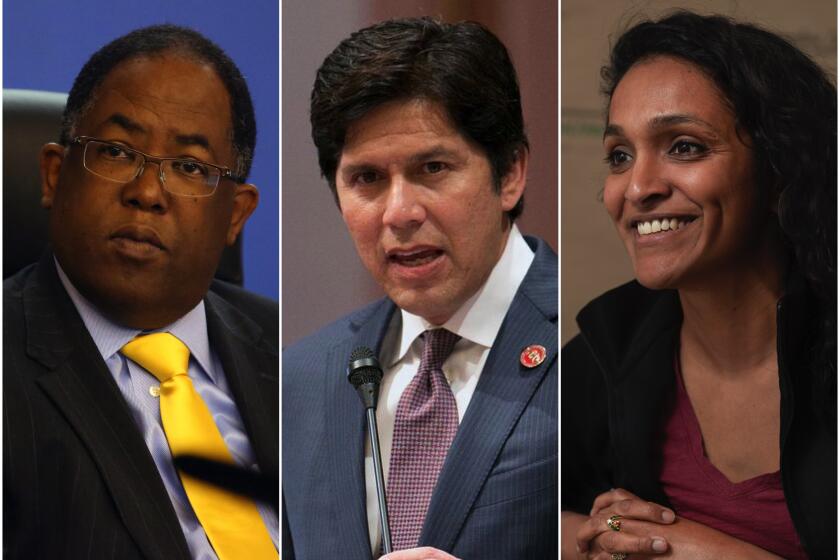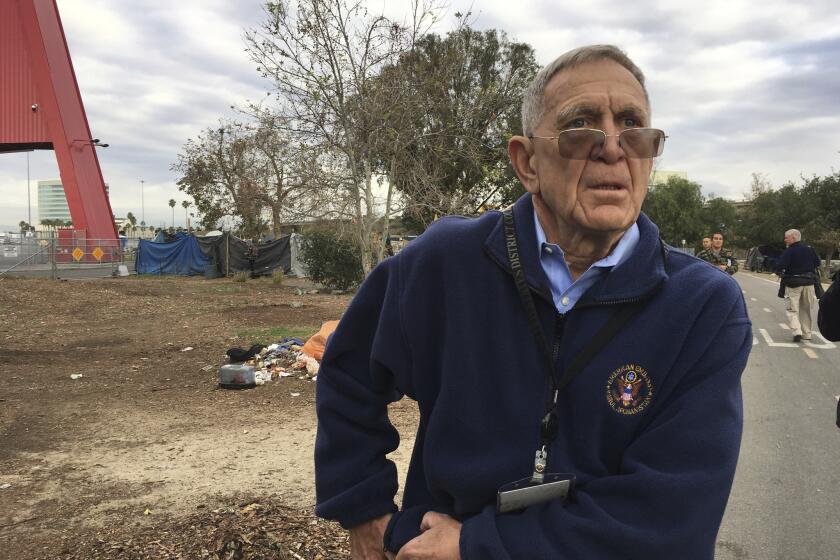In ‘a panic situation,’ L.A. may turn the convention center into a homeless shelter
Several members of the Los Angeles City Council have asked the city to study the feasibility of using the Los Angeles Convention Center, which has gone dark during the COVID-19 pandemic, to shelter homeless people.
This move is a reflection of the increasingly desperate situation thousands of homeless people face living on the streets. As coronavirus cases rise again in Los Angeles, the move is also a reflection of the increasingly slim chances of large-scale events at the convention center in the near future.
Councilman Curren Price, who introduced the motion, said in an interview that the pandemic had exacerbated conditions on the streets and that it was incumbent on elected officials to act more decisively during extraordinary times.
“We’re in a panic situation along with a pandemic situation. Folks on the streets are just suffering,” he said.
“Getting people off the street is important,” added Price, whose downtown district includes the convention center along Figueroa Street. “My sidewalk areas are just unpassable. It’s unfair for the neighbors — for those who are in the community — who can’t go down the sidewalk.... We have to do a better job of housing individuals who are homeless.”
The L.A. City Council’s three newest members bring experience on homelessness
All City Council members are under pressure from U.S. District Judge David O. Carter to shelter homeless people in their districts. Carter, who is overseeing a lawsuit alleging that the city and county have not done enough to get people off the street, has said he’d like each council member to set a target for the number of new beds they would create.
Price’s 9th District has more than 4,800 homeless residents, according to a 2020 count, second-highest in the city. Nearly half of those were sheltered, a rate well above the city average, but there were still nearly 2,700 people on the streets.
Carter has focused as well on areas near freeways, and Price’s district has one of the largest populations of people living beside a freeway. He said the convention center would help him shelter this group.
During the civil unrest in the aftermath of George Floyd’s death in Minnesota, the California National Guard used the center as a staging area for troops to sleep. When the pandemic began to rage, the National Guard set up a field hospital in the center in anticipation that local hospitals might be overwhelmed by coronavirus cases.
That never came to pass. Since then, the center has mostly sat empty, with state health rules prohibiting large-scale events such as Los Angeles Comic Con.
Judge David O. Carter, who has ruled that local agencies must clear homeless people from encampments alongside freeways, holds a hearing at City Hall — a reflection of how a legal case has made its presence felt in L.A. politics.
Price says he doesn’t see convention business returning for years. Others worry that, once hundreds of people are sheltered in the center, the lack of adequate supportive housing could strand them there long after the pandemic has passed.
Mayor Eric Garcetti said he was open to the idea of using the convention center as a shelter but didn’t want anything to come at the expense of using hotel and motel rooms, which he said have been a more effective way to move people off the street.
“I think it merits studying,” he said. “I’d like that report to be turned around quickly.”
Jessica Lall, president and chief executive of the Central City Assn. of Los Angeles, said that her organization supported homeless housing of all types but that she hoped the feasibility study would take into consideration downtown residents and examine whether “this is the highest and best use of the convention center and analyze the nexus of the convention center as an asset for generating revenue.”
Doane Liu, executive director of the city’s Department of Convention and Tourism Development, said he would follow the council’s direction but wanted to be sure it had a complete understanding of the cost and potential effects on the city’s economic recovery from the COVID-19 pandemic.
“We have to be realistic about what the costs are,” Liu said. “Specifically, our convention center does not have enough bathrooms, does not have any showers. When the building is empty, electricity and utilities are not on. Those are costs that are going to need to be borne by somebody.”
When the National Guard stayed there in May, the costs for furniture, portable bathrooms, showers, cleaning and meals added up to $1 million for six days, Liu said.
There’s also a potential conflict with use of the convention center for events such as the L.A. Auto Show.
“We have legally binding contracts for the convention center practically every day for the next five years,” Liu said. “Across the board, every one of our clients wants to have our event the minute the state allows it.”
Newly elected Councilman Kevin de León, who seconded Price’s motion, said in a statement that the convention center could be a safe refuge for unhoused Angelenos “now facing the long winter months with virtually no access to a warm place to sleep at night. Responding to this humanitarian crisis of biblical proportions requires us to be nimble and creative, doing everything in our power to move people off the street and indoors.”
Los Angeles wouldn’t be the first city to shelter homeless people in a convention center. At the beginning of the pandemic in late March, San Diego moved homeless people into its convention center.
By the summer, about 1,300 people were bedding down for the night in the cavernous facility. By the end of the year, when the center is expected to return to its original use, about $40 million will have been spent to run it as a shelter.
“This wasn’t a long-term financially sound solution. It’s not inexpensive,” said Ashley Bailey, spokeswoman for San Diego Mayor Kevin Faulconer.
More to Read
Sign up for Essential California
The most important California stories and recommendations in your inbox every morning.
You may occasionally receive promotional content from the Los Angeles Times.














